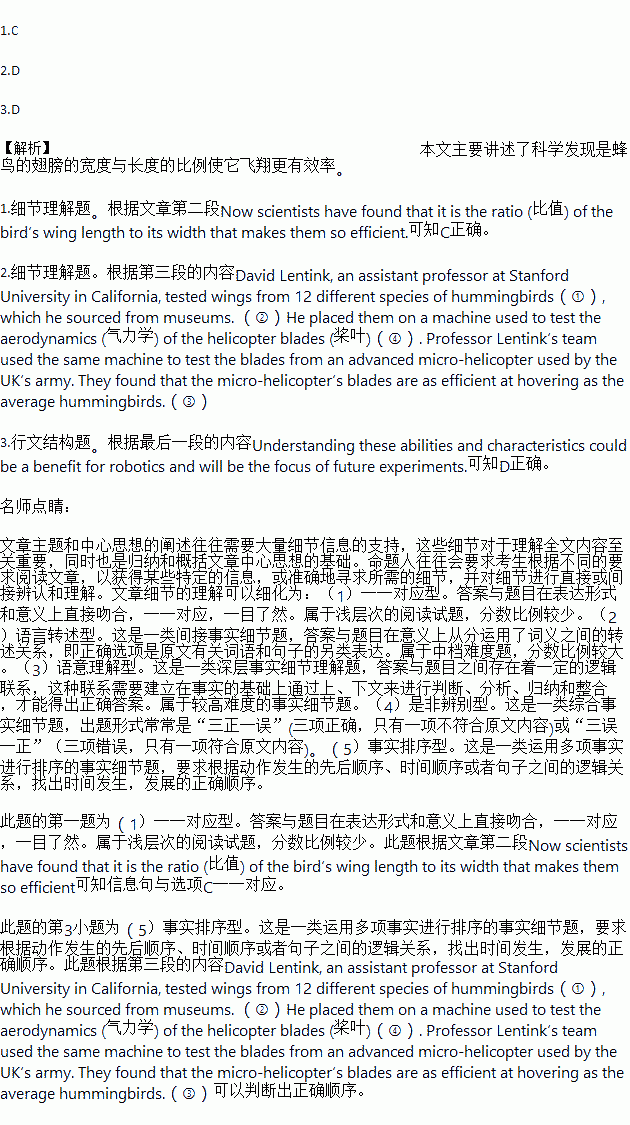题目内容
Hummingbirds (蜂鸟) are one of nature’s most energetic fliers and the only birds to hover in the air by relying on their strength alone.
Now scientists have found that it is the ratio (比值) of the bird’s wing length to its width that makes them so efficient. The discovery is helping experts compete with 42 million years of natural selection to build helicopters that are increasingly efficient.
David Lentink, an assistant professor at Stanford University in California, tested wings from 12 different species of hummingbirds, which he sourced from museums. He placed them on a machine used to test the aerodynamics (气力学) of the helicopter blades (桨叶). Professor Lentink’s team used the same machine to test the blades from an advanced micro-helicopter used by the UK’s army. They found that the micro-helicopter’s blades are as efficient at hovering as the average hummingbirds.
But while the micro-helicopter’s blades kept pace with the average hummingbird wings, they could not keep up with the most efficient hummingbird’s wing. The wings of Anna’s hummingbird were found to be about 27 percent more efficient than the man-made micro- helicopter’s blades.
While Professor Lentink wasn’t surprised at nature’s superiority, he said that helicopter blades have come a long way. “The technology is at the level of an average hummingbird,” he said. “A helicopter is really the most efficient hovering device that we can build. The best hummingbirds are still better, but I think it’s amazing that we’re getting closer. It’s not easy to match their performance, but if we build better wings with better shapes, we might match hummingbirds.”
Professor Lentink said that we don’t know how hummingbirds maintain their flight in a strong wind, how they navigate (确定方向) through branches, or how they change direction so quickly. He thinks that great steps could be made by studying wing aspect ratios—the ratio of wing length to wing width. Understanding these abilities and characteristics could be a benefit for robotics and will be the focus of future experiments.
1.What did the scientists find about hummingbirds?
A. Their wings are long and wide.
B. They can hover in the air for a long time.
C. The ratio of their wing length to wing width is very important.
D. They are the most energetic flier in nature.
2.Which is the right order of Professor Lentink’s research?
① Tested wings from different species of hummingbirds.
② Got resources from museums.
③ Analyzed the results and drew a conclusion.
④ Tested the blades from a micro-helicopter.
A. ①②③④ B. ②①③④ C. ②④①③ D. ②①④③
3.According to Professor Lentink, what will be the focus of future experiments?
A. To know how hummingbirds can fly in a strong wind.
B. To know how hummingbirds change direction so quickly.
C. To develop a new kind of helicopter.
D. To study the secrets of hummingbirds.
One recent Sunday I stood in church,video camera in hand,and(38)Cmy 68-year-old father play the piano in his very first recital.
My father had longed to play music since childhood,but his family was poor and couldn't(39)Blessons.He could have gone on regretting it,(40)A too many of us do.But he wasn't stuck in the past.When he retired three years ago,he(41)Dhis church music director to take him as(42)C.
For a moment after my father sat down at the keyboard,he stared down at his fingers.Has he forgotten the(43)C?I worried.But then came the beautiful melody (旋律).And I(44)B he had been doing what music teachers always stress:(45)Dthe notes and pretend the others aren't there.
"I'm(46)Dof him for starting something new at his age,"I said to my son Jeff.
"Yeah,and doing it so(47)A,"Jeff added.
With his first recital,my father taught me more about self-confidence and the life goal than all the words he used those 30-plus years ago.
| 36.A.reflected | B.meant | C.explained | D.proved |
| 37.A.self-confidence | B.self-control | C.self-defense | D.self-discipline |
| 38.Akept | B.sent | C.watched | D.felt |
| 39.A.miss | B.afford | C.select | D.understand |
| 40.A.as | B.once | C.if | D.while |
| 41.A.allowed | B.invited | C.inspired | D.persuaded |
| 42.A.ateacher | B.anoldman | C.astudent | D.asinger |
| 43.A.words | B.videos | C.notes | D.lessons |
| 44.A.predicted | B.realized | C.imagined | D.insisted |
| 45.A.passover | B.turnup | C.bringin | D.concentrateon |
| 46.A.ashamed | B.aware | C.tired | D.proud |
| 47.A.nicely | B.anxiously | C.casually | D.frequently |
| A. | what for | B. | what about | C. | How about | D. | what if |
| A. | Working | B. | To work | C. | Work | D. | Worked |

